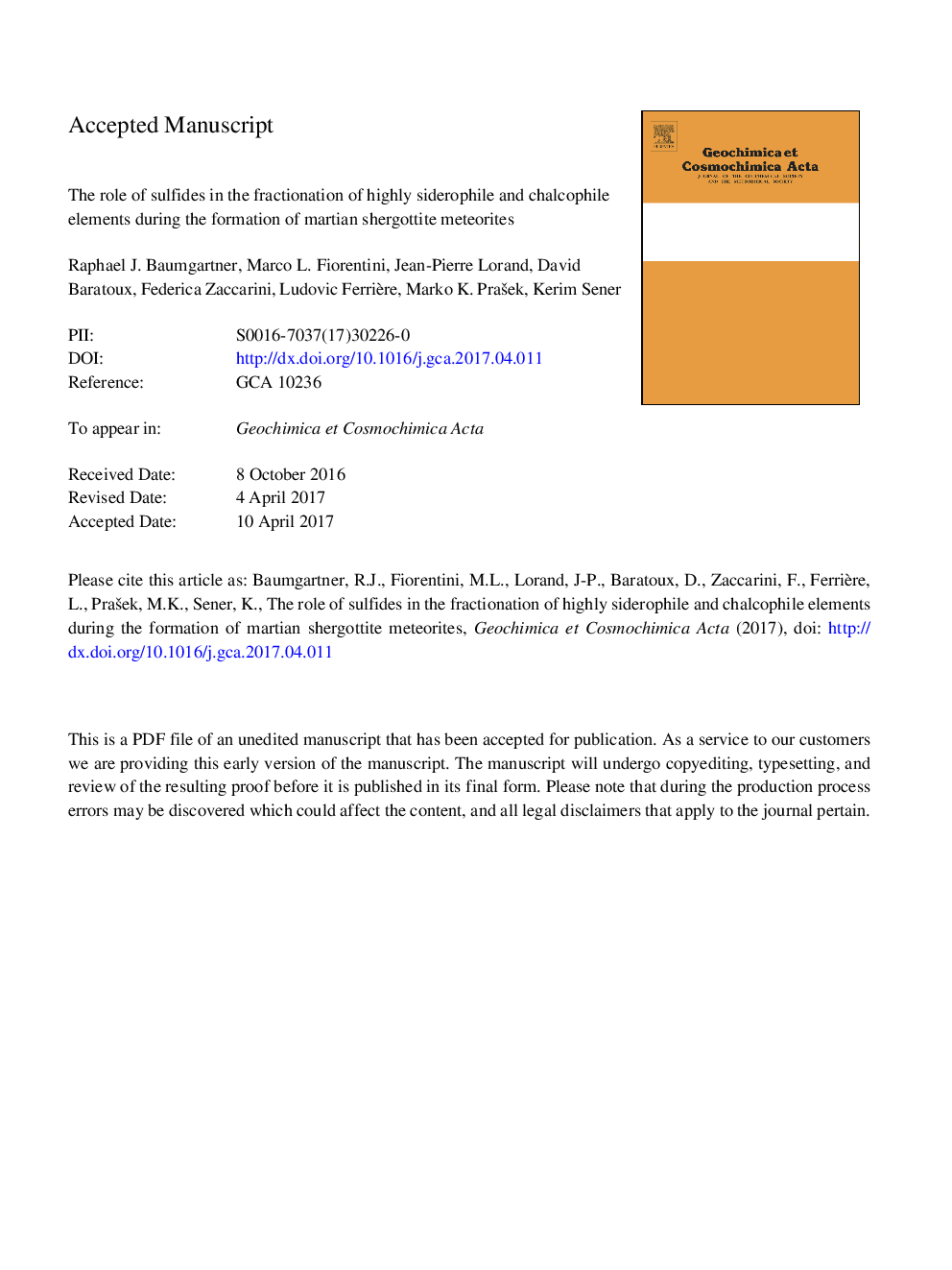| کد مقاله | کد نشریه | سال انتشار | مقاله انگلیسی | نسخه تمام متن |
|---|---|---|---|---|
| 5783188 | 1637947 | 2017 | 52 صفحه PDF | دانلود رایگان |
عنوان انگلیسی مقاله ISI
The role of sulfides in the fractionation of highly siderophile and chalcophile elements during the formation of martian shergottite meteorites
ترجمه فارسی عنوان
نقش سولفید ها در تقسیم بندی عناصر بسیار سیدروفیل و کلکوفیل در شکل گیری شهاب سنگ های مریخی شهوتیته
دانلود مقاله + سفارش ترجمه
دانلود مقاله ISI انگلیسی
رایگان برای ایرانیان
کلمات کلیدی
موضوعات مرتبط
مهندسی و علوم پایه
علوم زمین و سیارات
ژئوشیمی و پترولوژی
چکیده انگلیسی
The shergottite meteorites are ultramafic to mafic igneous rocks whose parental magmas formed from partial melting of the martian mantle. This study reports in-situ laser ablation inductively coupled plasma mass spectrometry analyses for siderophile and chalcophile major and trace elements (i.e., Co, Ni, Cu, As, Se, Ag, Sb, Te, Pb, Bi, and the highly siderophile platinum-group elements, PGE: Os, Ir, Ru, Rh, Pt and Pd) of magmatic Fe-Ni-Cu sulfide assemblages from four shergottite meteorites. They include three geochemically similar incompatible trace element- (ITE-) depleted olivine-phyric shergottites (Yamato-980459, Dar al Gani 476 and Dhofar 019) that presumably formed from similar mantle and magma sources, and one distinctively ITE-enriched basaltic shergottite (Zagami). The sulfides in the shergottites have been variably modified by alteration on Earth and Mars, as well as by impact shock-shock related melting/volatilization during meteorite ejection. However, they inherit and retain their magmatic PGE signatures. The CI chondrite-normalized PGE concentration patterns of sulfides reproduce the whole-rock signatures determined in previous studies. These similarities indicate that sulfides exerted a major control on the PGE during shergottite petrogenesis. However, depletions of Pt (and Ir) in sulfide relative to the other PGE suggest that additional phases such discrete Pt-Fe-Ir alloys have played an important role in the concentration of these elements. These alloys are expected to have enhanced stability in reduced and FeO-rich shergottite magmas, and could be a common feature in martian igneous systems. A Pt-rich PGM was found to occur in a sulfide assemblage in Dhofar 019. However, its origin may be related to impact shock-related sulfide melting and volatilisation during meteorite ejection. In the ITE-depleted olivine-phyric shergottites, positive relationships exist between petrogenetic indicators (e.g., whole-rock Mg-number) and most moderately to strongly siderophile and chalcophile elements in sulfides. These variations extend to incompatible elements like Te and Pd. The whole-rock concentrations of Pd derived from mass-balance calculations decrease by one order of magnitude in the order Y-980459, DaG 476 and Dhofar 019, and broadly overlap the trends in previously published whole-rock analyses. Mantle heterogeneities, and the timing of sulfide saturation as function of mantle melting and/or magma fractionation following ascent from the mantle, may have been the controlling factors of the siderophile and chalcophile element systematics in the analyzed shergottites.
ناشر
Database: Elsevier - ScienceDirect (ساینس دایرکت)
Journal: Geochimica et Cosmochimica Acta - Volume 210, 1 August 2017, Pages 1-24
Journal: Geochimica et Cosmochimica Acta - Volume 210, 1 August 2017, Pages 1-24
نویسندگان
Raphael J. Baumgartner, Marco L. Fiorentini, Jean-Pierre Lorand, David Baratoux, Federica Zaccarini, Ludovic Ferrière, Marko K. Prašek, Kerim Sener,
